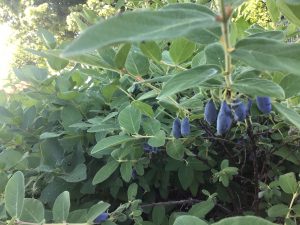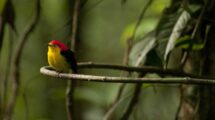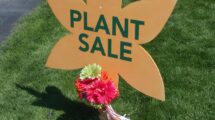In the Garden
By Karen Hawley
 A few years ago, in my Veseys catalogue, I read of a “new” berry that was gaining popularity. It was the fruit of a native honeysuckle called the haskap or honeyberry. I was intrigued and bought four shrubs to plant on a property just out of town. They are still alive, but that’s about all I can report—no fruit yet! So, I started to read more, in an effort to find out how to get my haskap plants to produce some berries.
A few years ago, in my Veseys catalogue, I read of a “new” berry that was gaining popularity. It was the fruit of a native honeysuckle called the haskap or honeyberry. I was intrigued and bought four shrubs to plant on a property just out of town. They are still alive, but that’s about all I can report—no fruit yet! So, I started to read more, in an effort to find out how to get my haskap plants to produce some berries.
A fellow Master Gardener who has haskap shrubs that have produced berries, tells me that their May flowers buzz with pollinators. Their flowers are a flounce of small, pale-yellow clusters very similar in form to the pink honeysuckle bloom. It would seem to be a great addition to any pollinator garden, with the added benefit of being native, so ecologically appropriate to our area.
The haskap (Lonicera caerulea) is a member of the honeysuckle family. It is a woody shrub, anywhere from one to two metres tall and one-and-a-half to two metres wide, at maturity. Traditionally, it was and still is, used by the natives of the northern islands in Japan and into Russia for its medicinal benefits. Wild species have been found across Canada ranging from zone 2 south to zone 4. Its cold hardiness is a real draw for Ottawa gardeners, plus it does not sucker, has no thorns and few pests.
The key to producing berries is to have a companion variety planted nearby, only a few metres away. All haskaps have both male and female parts in every flower, but they are not self-fertile, so they need a different but close relative for cross-pollination with the help of bees. The companion variety may not bear desirable fruit, but its pollen will trigger fruit bearing in the desirable shrubs. Only then, will they produce their sumptuous blue-purplish, oblong berries (two-and-a half to six centimetres). If a grower needs to plant two or three shrubs, each two metres wide at maturity, a small city yard or an allotment garden might not be big enough to accommodate multiple bushes.
When choosing varieties, it is important to note that there are variations in blooming times, making the choice of variety an important element in achieving success—the plants must be blooming at the same time for cross-pollination. The Saskatchewan breeders (see sidebar) have cleverly named their hybrid companions with associated words: Aurora can be a companion to Borealis, (Boreal) Beauty can be a companion to (Boreal) Beast. Other pairs may work too, depending on your zone and how this may shift bloom times.
Another plus for the haskap is their “super food” designation. With more antioxidants, like anthocyanins, polyphenols and bioflavonoids, they beat out blueberries for their health benefits. They are available as dried berries, in jams and juices, in chutneys, yogurt, gelato and are used in multiple baked goods. They are as versatile as any berry.
In North America they are now taking off with a marketing focus on fresh produce. To bring any new food product to market requires years of breeding. We have Bob Bors and his team at the Department of Plant Sciences, University of Saskatchewan, to thank. Their hybrids have steadily improved, making haskap berries more hardy, attractive, palatable and suitable for mechanical harvesting. Viable breeds with a decent harvest are being produced regularly.
When your home-grown shrubs begin to produce, the berries will turn a lovely blue colour, but may not be fully ripe. If they are firm, they will likely still be too sour. Wait until they are a bit soft and they will be sweet and delicious. A fellow gardener told me, “If you’re impatient like me, you will eat a few tart ones before they ripen fully.”
Chances are you will have competition for those lovely berries! Squirrels, rabbits and birds alike will be after them. A suggestion for growers is to use the companion variety (the one with the less delicious fruit) as a guard row to protect the desirable crop from hungry birds. Netting over the shrubs after the flowers have fallen may do the trick as well.
A fellow Master Gardener describes her haskaps as bearing loads of fruit. They were initially planted from root cuttings and now at five years old they are about a metre tall. Other sources suggest that as soon as one year after planting 30-centimetre tall shrubs, they will flower and produce fruit if they have a suitable companion plant.
My shrubs are clearly old enough, but likely need more TLC and attention, or a more suitable companion. Mine have lots of sunshine, although haskaps will manage in partial sun. Perhaps the lack of fruit may be because my soil is too acidic; although, a range of slightly acidic to slightly alkaline soil is appropriate for haskaps. Another possible cause for the lack of fruit is a nutrient deficit in the soil—I have not added additional compost to this area but that can be easily remedied. Deer browsing may be the most significant impediment to these shrubs flourishing but netting or fencing to slow down the deer assault would solve that problem. Clearly, I have some work ahead of me to ensure a tasty crop—but hope springs eternal!
Karen Hawley is a landscape ecologist who has championed organic gardening, forest farming and forest education for preschoolers. She is a volunteer with the Master Gardeners of Ottawa-Carleton)






